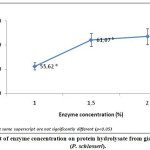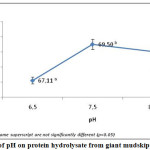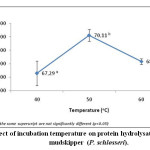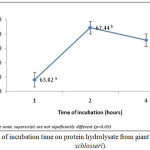Introduction
Giant mudskippers (Periophthalmodon schlosseri) are amphibious fish and considered as endemic fish, so it can not be found in any other place and they live in a typical habitat in a tidal area with the mud of mangroves. These fish is relatively untapped as food source because of its morphology and its habitat in mudflats. However, in certain areas, it can be used as food source and known as functional food to increase energy for body. Mudskipper contains relatively large protein approximately 56%1 , so it has the potential to be used as a source for protein hydrolysate and food product development that combine nutrition and health function as a nutraceutical, such as antioxidants.2,3 4 .
The enzymatic hydrolysis has been widely used in various protein derived from different aquatic sources to produce functional fish protein hydrolysate.5,6,7,8,9,10,11,12,13,14 . One of the proteolytic enzymes used was alcalase enzyme. Alcalase, is an endo-protease of the serine type with a broad specificity which performs well in alkaline conditions and was manufactured from Bacillus licheniformis a by Novo Nordisk (Bagsvaerd, Denmark) as addictive material of detergent industry. Moreover, alcalase enzyme is one of the best enzymes that has been widely used by many researchers to manufacture functional fish protein hydrolysate (FPH).15,16,17
Research on the fish protein hydrolysate (FPH) from giant mudskipper has not been widely studied, therefore this research aims to obtain the optimum conditions of the hydrolysis of fish protein hydrolysate from giant mudskipper using alcalase enzyme.
Material and Method
Materials
Giant mudskipper (Periophthalmodon schlosseri) weighing 200 – 400 grams/each were obtained from the coastal of Malacca Strait in Lima Laras Village, Tanjung Tiram District, Batubara Regency, Indonesia resulting in a total sample weight of 10 kgs. The fish is immediately taken to the laboratory using ice box to keep it fresh. After the thawing process, the head, bone, and stomach contents were removed. Fish flesh was used for the process of making fish protein hydrolysate. Proteolytic enzyme used was 2.4 L alcalase enzyme (2,4 AU-A/g) obtained from Novozyme (Bagsvaerd, Denmark).
Preparation of Fish Protein Hydrolysate
Fish flesh was minced and dried on waterbath at 50oC for 20 minutes to inactivate endogenous enzyme in fish flesh. Then, it was cooled in an incubator and crushed into flour. The dried material was made into flour by grinding in mortars with a size of around 60 mesh. Dried samples are called fish protein concentrate.
The preparation of fish protein hydrolysate was carried out by enzymatic hydrolysis using alcalase enzyme with variations of four different paramaters consisted of enzyme concentration, temperature, pH, and incubation time. Only one parameter is varied at a time to determine its effect without considering interactions with other parameters. The purpose of varying the four parameters was to determine the optimum conditions of the hydrolysis process.
Determination of the optimum conditions on the degree of hydrolysis of the four parameters was consisted of enzyme concentrations ranging from 0.5%, 1.5% and 2.5% to the weight of fish protein, varying pH from 6.5; 7.5 and 8.5, the temperatures of hydrolysis at 40°C, 50°C and 60°C, and the incubation time for 1, 2 and 4 hours.
The hydrolysis of fish protein from giant mudskipper was carried out by enzymatic hydrolysis using the alcalase enzyme. A total of 10 grams of fish protein concentrate was homogenized with a specific pH of 0.1 M phosphate buffer solution (pH 6.5; 7.5 and 8.5) at a ratio of 1:2 (w/v). Initially, the hydrolysis of fish protein was added to alcalase at a concentration of 1%, 1.5 % and 2% by weight of fish protein. Furthermore, the mixture was incubated for 1, 2, and 4 hours at 40°C, 50°C and 60°C using a water bath and temperature control. The hydrolysis process is carried out with continuous stirring. Enzyme activity was stopped by raising the stirring temperature to 85°C for 10 minutes. The protein hydrolysate obtained was left to stand on room temperature and centrifuged at a 10000 rpm for 20 minutes. The supernatant was filtered with filter paper and the degree of hydrolysis was analyzed.
Optimum hydrolysis conditions were determined from the degree of hydrolysis (%DH) produced at the enzyme concentration, pH, temperature, and optimal incubation time.
Determining Degree of Hydrolysis
The degree of hydrolysis (%DH) of fish protein hydrolysate is determined based on the ratio of percentage nitrogen dissolved in 10% Trichloroacetic Acid Solution (TCA) to the total amount of protein nitrogen in the sample, such as the method discovered by Hoyle and Merritt .18 10 mL of Protein hydrolysate obtained was mixed with 10 mL of 20% TCA solution (w/v) at ratio of 1:1 to manufacture 10% TCA solution. Furthermore, the mixture was left to stand for 30 minutes to precipitate insoluble material. After 30 minutes, it was centrifuged at 7500 rpm for 15 minutes and supernatant was calculated with Kjeldahl method to determine non-protein nitrogen content .19 Furthermore, DH was calculated using the formula as follows:

All data were obtained from three replications and analyzed using SPSS 17.0 software with the analysis of variance analysis (ANOVA) from a completely randomized factorial design at α 0.05. To deicede whether the treatment has a significant effect, further test was used with LSD (Least Significance Different) to determine the difference between the treatment combinations.
Results and Discussion
The Optimum Hydrolysis of Enzyme Concentration
The pattern fo the effect of enzyme concentration on the degree of hydrolysis of alcalase enzyme in the protein hydrolysate from giant mudskipper (P. schlosseri) is presented in Figure 1. The degree of hydrolysis was increasing in accordance with the increase in concentration of the alcalase enzyme. The use of 1% alcalase enzyme concentration in the hydrolysis process resulted in a relatively large degree of hydrolysis (55.62%). The use of 1.5% alcalase enzyme concentration increased the degree of hydrolysis from 55.62% to 61.07%. The increase of the degree of hydrolysis would be slow after the use of alcalase enzyme concentration at 2% with 61.79%.
 |
Figure 1: Effect of Enzyme Concentration on Protein Hydrolysate from Giant Mudskipper (P. Schlosseri). Click here to View figure |
The results show the use of 1% alcalase enzyme concentration with 1.5% and 2% alcalase enzyme concentrations had significant difference on the average value of the degree of hydrolysis. On the contrary, the use of alcalase enzyme concentrations of 1.5% and 2.5% had no significant difference. Increasing the enzyme concentration would increase the interaction of enzyme molecules with fish flesh particles and would release more soluble protein to the system.20,15 Bhaskar and Mahendrakar reported that increasing the concentration of alcalase enzymes in the hydrolysis of Catla catla protein would increase the overall rate of proteolysis and protein dissolution.21 A study by Benjakul and Morrissey also showed an increasing of the concentration of alcalase enzyme increased the total rate of proteolysis.17
The pattern of increasing the degree of hydrolysis increased rapidly at enzyme concentrations of 1 – 1.5% and increased slowly at an enzyme concentration of 2% because of the availability of peptide bonds to be hydrolyzed and as a limiting factor. Liceaga-Gesualdo and li-Chan stated that enzymes added to the substrate would be absorbed to the particle suspension, where the hydrolysis of peptide bonds by the enzymes would occur simultaneously.11 After the initial rapid hydrolysis phase, the rate of hydrolysis would reduce entering the passive phase. At this point, the peptide bonds available for hydrolysis could be a limiting factor. Guerard et al reported that this slowing down of proteolysis could be caused by a decrease in the concentration of peptide bonds that could be hydrolyzed by the enzyme concerned.22,23 Moreover, Diniz et al stated that after all substrates in the system are connected to the active side of the enzyme, there would be a free enzyme that could inhibit the hydrolysis process and to hydrolyze its enzyme.24
Furthermore, a study by Benjakul and Morrissey also showed significant changes occurring with enzyme treatment at concentrations ranging from 0 to 34 AU/kg. However, there was no significant increase in enzyme concentrations above 57 AU/kg.17 A study by Novikov also showed kinetic studies involving the hydrolysis of Atlantic cod proteins. The constant rate of hydrolysis reaction increased with an increase in the concentration of the enzyme added to 3 g/kg of raw material. Futher increase in enzyme concentration to 7 g/kg did not affect the constant rate of reaction.25
Based on the statement above, the use of 1.5% alcalase enzyme concentration had an optimal degree of hydrolysis and potential as a hydrolysis condition for the stage of making hydrolysates.
Effect of pH Hydrolysis
The pattern of the effect of pH on the degree of hydrolysis of alcalase enzyme in the fish protein hydrolysate from giant mudskipper (P. schlosseri) is presented in Figure 2. The depiction of the hydrolytic curve is parabolic. Increasing the pH of 1 unit (from 6.5 to 7.5) would increase the hydrolysis of alcalase enzyme by 3.6% (from 67.11% to 69.50%). When the pH increase was higher to 8.5, there was a decrease in the degree of protein hydrolysis by 0.7% (from 69.50% to 69.02%). It can be seen that alcalase enzyme showed activity in the range of alkaline pH or alkaline protease and still remained active at pH 6.5.
The results show that there was an effect of pH on the average degree of hydrolysis of giant mudskipper flesh. Furthermore, there were differences in the use of pH 6.5 with pH 7.5 and 8.5 on the average value of the degree of hydrolysis. Conversely, the use of pH of 7.5 and 8.5 had no significant difference. Thus, the optimum pH value for the hydrolysis of the giant mudskipper protein hydrolysate using alcalase enzyme was at pH 7.5.
 |
Figure 2: Effect of pH on Protein Hydrolysate from giant Mudskipper (P. Schlosseri). Click here to View figure |
Benjakul and Morrissey stated that the optimal pH for alcalase in the hydrolysis of fish waste proteins was 9.5.17 This difference might be caused by different substrates. Adler-Nissen stated that the stability of the substrate and enzyme was determined by the charge distribution and molecular conformation which were directly affected by pH,26 whereas according to Whitaker , most enzyme underwent irreversible denaturation in highly acidic and base solutions, causing a loss of stability. Furthermore, the ionization of the prototrophic groups (pH) as maintaining the conformation of the active side of the enzyme was appropriate in binding the subtrate to produce the product.27
Based on the statement above that the use of pH 7.5 had an optimal value of the degree of hydrolysis, the hydrolysis conditions of pH 7.5 then would be used as a hydrolysis condition for the stage of making hydrolysates.
Effect of Hydrolysis Temperature
The pattern of the effect of temperature on the degree of hydrolysis of the alcalase enzyme in the fish protein hydrolysate from giant mudskipper (P. schlosseri) is presented in Figure 3. Similar to the effect of pH on the degree of hydrolysis of alcalase enzyme, the depiction of the hydrolytic curve of the effect of hydrolysis temperature was also parabolic. The pattern of changing the degree of hydrolysis was fluctuative and increasing. Increasing the optimal degree of hydrolysis occurred at the use of 50°C hydrolysis temperature of 4.2% (from 67.29% to 70.11%), and higher temperature increased to 60oC caused a significant decrease in hydrolysis of 2.8% (from 70.11% to 68.17%).
The results show that there was a temperature effect on the average degree of hydrolysis of the giant mudskipper flesh. Furthermore, there was a difference in the use of temperature 40°C and 50°C to the average value of the degree of hydrolysis. Conversely, the use of temperature 40°C has no significant difference with 60°C and the use of temperature 50°C was no significantly different with 60°C. Thus, the optimum temperature value for the giant mudskipper protein hydrolysate using alcalase enzyme was at 50°C.
 |
Figure 3: Effect of Incubation Temperature on Protein Hydrolysate from Giant Mudskipper (P. Schlosseri). Click here to View figure |
A significant decrease in activity at 60°C was estimated by thermal denaturation. Baek and Cadwallader stated that the optimal temperature of alcalase enzyme use in the process of crayfish was 70°C because of reaction conditions and different substrate.28
The Optimum condition of Hydrolysis Time
The pattern of the effect of the hydrolysis time on the degree of hydrolysis of alcalase enzymes on fish protein hydrolysate from giant mudskipper (P. schlosseri) is presented in Figure 4. Similar to the effect of pH and temperature on the degree of hydrolysis of alcalase enzyme, the depiction of the hydrolytic curve of the hydrolysis incubation time was also parabolic. The pattern of changing the degree of hydrolysis was fluctuative and increasing. Increasing the optimal degree of hydrolysis occurred at the hydrolysis time for 2 hours by 5.7% (from 63.82% to 67.44%), and higher time increased to 4 hours caused a significant decrease in hydrolysis of 1.3% (from 67.44% to 66.59%).
 |
Figure 4: Effect of Incubation Time on Protein Hydrolysate from Giant Mudskipper (P. Schlosseri). Click here to View figure |
The results show that there was the effect of the incubation time on the average degree of hydrolysis of mudskipper flesh. Furthermore, there was a difference in the use of 1 hour incubation time with an incubation time of 2 and 4 hours on the average value of the degree of hydrolysis. Conversely, the use of incubation time for 2 and 4 hours did not have significant difference.
After the initial rapid hydrolysis stage, the rate of hydrolysis would tend to slow down, so peptide bonds available for hydrolysis could be a limiting factor. Guerard et al reported that the slowing of proteolysis could be caused by a decrease in the concentration of peptide bonds that could be hydrolyzed by the enzyme concerned and reducing the enzyme activity.22 The decreasing rate of hydrolysis might also be caused by reduced substrate concentration and enzyme deactivation. Guerard et al stated that an increase in time above 5.5 hours did not increase the degree of hydrolysis significantly and optimal hydrolysis occurred at 4 hours.22 This difference might be due to different substrates and reaction conditions. Lydia et al reported higher degree of hydrolysis (83%) for Dagaa (Rastrineobola argentes) hydrolysates prepared using alcalase 2% with hydrolysis conditions were fixed at 56°C, pH 7 for 6 hours.29 In addition, the using alcalase 2.5%, temperature of 55.30°C and pH of 8.39 were found to be the optimum conditions to obtain the highest degree of hydrolysis (77.03%) for salmon (Salmo salar) skin.30
Conclusions
The result of this research are based on the degree of hydrolysis, showing that an increase in enzyme concentration from 1% to 1.5%, an increase in pH from 6.5 to 7.5, an increase in temperature from 40°C to 50°C, hydrolysis time from 1 hour to 2 hours would increase degree of hydrolysis significantly. Futhermore, the optimum conditions for giant mudskipper protein hydrolysate using alcalase enzyme were at an enzyme concentration of 1.5% by weight of protein, pH 7.5, temperature of 50°C, and hydrolysis duration of 2 hours. The degree of hydrolysis produced at this optimum condition was 67.44%.
Funding
The author(s) received no financial support for the research, authorship, and/or publication of this article.
Conflict of Interest
The authors declare no conflict of interest.
References
- Andem A.B., Ekpo P.B. Proximate and Mineral Compositions of Mudskipper Fish (Periophthalmus babarus) in the Mangrove Swamp of Calabar River, Southern Nigeria. Inter Jour Sci Tech. 2014; 2(3): 72-76.
- Chun Wu H., Hua-Ming Chen., Chyuan-Yuan Shiau. Free Amino Acids and Peptides as Related to Antioxidant Properties in Protein Hydrolysates of Mackerel (Scomber austriasicus). Food Res Inter. 2003; 36: 949-957.
CrossRef. - Betty M., Awuor L., Kirwa M.E., Jackim M.F. Antioxidative and Functional Properties of Rastrineobola Argentea (Dagaa) Fish Protein Hydrolysate. J Agric Food Sci. 2014; 2(6): 180-189.
- Jeevitha K., Mohana P.K., Khora S.S. Antioxidant Activity of Fish Protein Hydrolysates from Sardinella Longiceps. In J Drug Dev & Res. 2014; 6(4): 137-145.
- Liu J., Lyu F., Zhou X., Wang B., Wang X., Ding Y. Preparation of Skipjack Tuna (Katsuwonus pelamis) Protein Hydrolysate Using Combined Controlled Enzymatic Hydrolisis and Glycation for Improved Solubility and Emulsifying Prooerties. J Food Nutr Res. 2015; 3(7): 471-477.
- , Huda N., Rosam A., Wan Nadiah W.A. Degree of Hydrolysis and Free Tryptophan Content of Skipjack Tuna (Katsuwonus pelamis) Protein Hydrolysates Produced with Different Type of Industrial Proteases. Inter Food Res Jour. 2012; 19(3): 863-867.
- Ovissipour M., Benjakul S., Safari R., Motamedzadegan A. Fish Protein Hydrolysates Production from Yellowfin Tuna Thunnus albacares Head using Alcalase and Protamex. Inter Aqua Res. 2010; 2: 87-95.
- Balti R., Bougatef A., Ali N.E., Ktari N., Jellouli K., Nedjar-Arroume N., Dhulster P., Nasri M. Comparative Study on Biochemical Properties and Antioxidative Activity of Cuttlefish (Sepia officinalis) Protein Hydrolysates Produced by Alcalase and Bacillus licheniformis NH1 Proteases. Research Article in Jour Amino Acids. Article ID 107179. 2011; 11.
CrossRef. - Souissi N., Bougatef A., Triki-Ellouz Y., Nasri M. Biochemical and Functional Properties of Sardinella (Sardinella aurita) By-Product Hydrolysates. Food Tech 2007; 45(2): 187-194.
- Atmani N., Dehiba F., Allaoui A., Barkia A., Bougatef A., Lamri-Senhadji Y., Nasri M., Boualga A. Sardina pilchardus and Sardinella aurita Protein Hydrolysates Reduce Cholesterolemia and Oxidative Stress in Rat Fed High Cholesterol Diet. J Exp Integr Med. 2015; 5(1): 47-54.
CrossRef. - Liceaga-Gesualdo A.M., Li-Chan E.C.Y. Functional Properties of Fish Protein Hydrolysate from Herring (Clupea harengus). J Food Sci. 1999; 64(6): 1000-1004.
CrossRef. - Sathivel S., Bechtel P.J., Smiley S., Crapo C., Reppond K.D., Prinyawiwatkul W. Biochemical and Functional Properties of Herring (Clupea harengus) Byproduct Hydrolysates. J Food Sci. 2003; 68(7): 2196-2200.
CrossRef. - Taheri A., Anvar S.A.A., Ahari H., Fogliano V. Comparison the Functional Properties of Protein Hydrolysates from Poultry Byproduct and Rainbow Trout (Onchorhynchus mykiss) Viscera. Iranian Jour Fish Sci. 2012; 12(1): 154-169.
- Wisuthiphaet N., Kongruang S. Production of Fish Hydrolysates by Acid and Enzymatic Hydrolysis. J Medic Bioengin. 2015; 4(6): 466-470.
CrossRef. - Shahidi F., Han X-Q., Synowiecki J. Production and Characteristics of Protein Hydrolysates from Capelin (Mallotus villosus). Food Chem. 1995; 53:285.
CrossRef. - Quaglia G. B., Orban E. Enzymatic Solubilisation of Proteins Sardine (Sardina pilchardus) by Commercial Proteases. J Sci Food Agric. 1987; 38: 263-269.
CrossRef. - Benjakul S., Morrissey M.T. Protein Hydrolysates from Pacific Whiting Solid Wastes. J Agric Food Chem. 1997; 45: 3423-3430.
CrossRef. - Hoyle N.T. Merritt J.H. Quality of Fish Protein Hydrolysate from Herring (Clupeaharengus). J Food Sci. 1994; 69: 615-619.
- AOAC Association Official Analytical Chemist’s Technical Standard. 2001. Official Methods of Analysis.
- Kristinsson H.G., Rasco B.A. Fish Protein Hydrolysates: Production, Biochemical, and Functional Properties. Critical Reviews in Food Sci Nutr. 2000; 40(1): 43-81.
CrossRef. - Bhaskar N., Mahendrakar N.S. Protein Hydrolysate from Visceral Waste Proteins of Catla (Catla catla): Optimization of Hydrolysis Conditions for a Commercial Neutral Protease. Biores Tech. 2008; 99: 4105-4111.
CrossRef. - Guerard F., Dufosse L., De La Broise D., Binet A. Enzymatic Hydrolysis of Proteins from Yellowfin Tuna (Thunnus albacares) Wastes using Alcalase. J Molec Catal B: Enzymatic. 2001; 11: 1051–1059.
CrossRef. - Guerard F., Guimas L., Binet A. Production of Tuna Waste Hydrolysates by a Commercial Neutral Protease Preparation. J Molec Catal B: Enzymatic. 2002; 19-20: 489-498.
CrossRef. - Diniz F.M., Martin A.M. Effects of the Extent of Enzymatic Hydrolysis on Functional Properties of Shark Protein Hydrolysate. LWT- Food Sci Tech. 1997; 30(3): 266-272.
CrossRef. - Novikov V.Y., Derkach S.R., Kuchina Y.A., Shironina A.Y., Mukhin V.A. Kinetics of Enzymatic Reactions in the Production of Fish Protein Hydrolysates. J Disp Sci Tech. 2017; 1-8.
- Adler-Nissen J. A Review of Food Protein Hydrolysis Specific Areas: Enzymes Hydrolysis of Food Proteins. Elsevier Applied Sciences Publication, New York, ISBN: 100853343861. 1986; 57-131.
- Whitaker J. R. Principles of Enzymology for the Food Sciences. Dekker. New York. 1994; 271-328.
- Baek H. H., Cadwallader K. R. Enzymatic Hydrolysis of Crayfish Processing By-Products. J Food Sci. 1995; 60(5): 929-935.
CrossRef. - Lydia Awuor, Edward K.M., Betty M., Francis J.M. Optimization of Alcalase Hydrolysis Conditions for Production of Dagaa (Rastrineobola argentea) Protein hydrolysate with Antioxidative Properties. Ind Chem. 2017: 3(1): 1-6.
CrossRef. - See S.F., Hoo L.L., Babji S. Optimization of Enzymatic Hydrolysis of Salmon (Salmo salar) Skin by Alcalase. Int Food Res Jour. 2011: 18(4): 1359-1365.

This work is licensed under a Creative Commons Attribution 4.0 International License.







